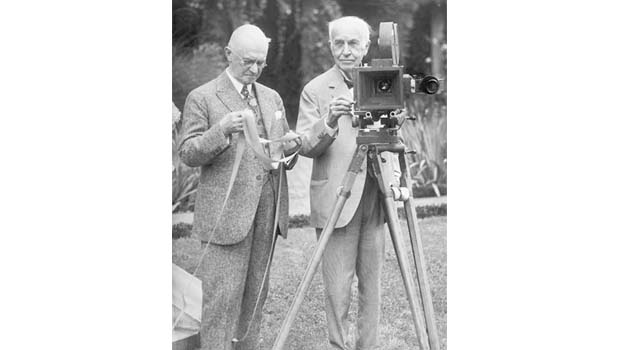This Day in History
Edison patents the movie camera


Thomas Edison receives a patent for his movie camera, the Kinetograph. Edison had developed the camera and its viewer in the early 1890s and staged several demonstrations.
The camera was based on photographic principles discovered by still-photograph pioneers Joseph Nicephone Niepce and Louis Daguerre of France. In 1877, inventor Edward Muybridge developed a primitive form of motion pictures when Leland Stanford, governor of California, invited him to develop photo studies of animals in motion. Muybridge developed an ingenious system for photographing sequential motion, setting up 24 cameras attached to trip wires stretched across a racetrack.
As the horse tripped each wire, the shutters snapped. The resulting series of photos could be projected as something resembling a motion picture. This breakthrough in the early 1870s inspired another student of animal motion, Etienne Jules Marey of France, to develop in 1882 a rotating camera rather like a rifle, where different pictures were taken in a rapid sequence by a rotating cartridge.
The concept of moving images as entertainment was not a new one by the latter part of the 19th century. Magic lanterns and other devices had been employed in popular entertainment for generations. Magic lanterns used glass slides with images which were projected. The use of levers and other contrivances made these images “move”.
Another mechanism called a Phenakistiscope consisted of a disc with images of successive phases of movement on it which could be spun to simulate movement. Additionally, there was the Zoopraxiscope, developed by photographer Eadweard Muybridge in 1879, which projected a series of images in successive phases of movement. These images were obtained through the use of multiple cameras. The invention of a camera in the Edison laboratories capable of recording successive images in a single camera was a more practical, cost-effective breakthrough that influenced all subsequent motion picture devices.
While there has been speculation that Edison’s interest in motion pictures began before 1888, the visit of Eadweard Muybridge to the inventor’s laboratory in West Orange in February of that year certainly stimulated Edison’s resolve to invent a motion picture camera. Muybridge proposed that they collaborate and combine the Zoopraxiscope with the Edison phonograph.
Although apparently intrigued, Edison decided not to participate in such a partnership, perhaps realizing that the Zoopraxiscope was not a very practical or efficient way of recording motion. In an attempt to protect his future inventions, Edison filed a caveat with the Patents Office on October 17, 1888, describing his ideas for a device which would “do for the eye what the phonograph does for the ear” — record and reproduce objects in motion. Edison called the invention a “Kinetoscope,” using the Greek words “kineto” meaning “movement” and “scopos” meaning “to watch.”
Unlike these earlier cameras, Edison’s Kinetoscope and Kinetograph used celluloid film, invented by George Eastman in 1889. In February 1893, Edison built a small movie studio that could be rotated to capture the best available sunlight. He showed the first demonstration of his films—featuring three of his workers pretending to be blacksmiths—in May 1893.
In 1898, Edison sued American Mutoscope and Biograph Pictures, claiming that the studio had infringed on his patent for the Kinetograph. He had entrusted the development of the machine to his assistant, W.L.K. Dickson, who left Edison’s company in 1895 and helped found Biograph.
-History

